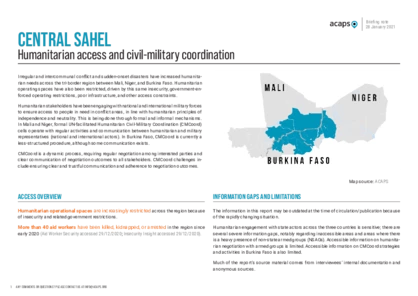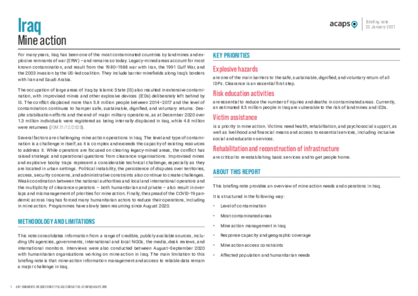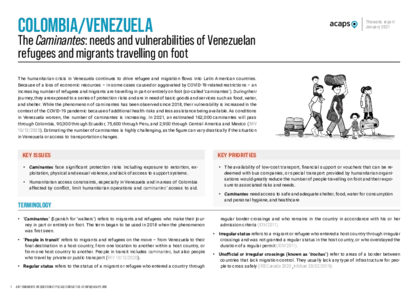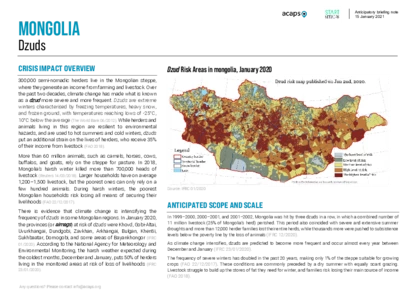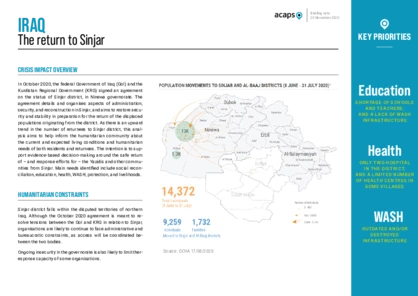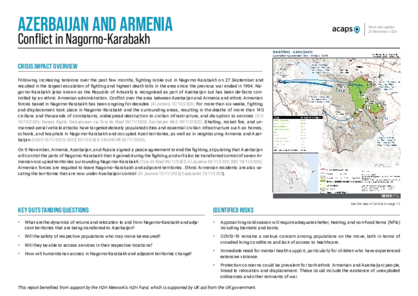Explore our
analysis products
archive
08 February 2021
Considering age and disability in the Rohingya response
DOCUMENT / PDF / 309 KB
This report highlights the challenging life in congested refugee camps for over 866,000 stateless Rohingya refugees struggling to meet their basic needs. For people with disabilities and older people living in the camps, such challenges are amplified.
Attached resources
28 January 2021
Central Sahel: Humanitarian access and civil-military coordination
DOCUMENT / PDF / 924 KB
Irregular and intercommunal conflict and sudden-onset disasters have increased humanitarian needs across the triborder region between Mali, Niger, and Burkina Faso. Humanitarian operating spaces have also been restricted.
22 January 2021
Iraq: Mine Action
DOCUMENT / PDF / 665 KB
This briefing note provides an overview of mine action needs and operations in Iraq. It consolidates information from a range of credible, publicly available sources, including UN agencies, governments, international and local NGOs, the media, desk reviews, and international monitors.
22 January 2021
Bosnia and Herzegovina: Mixed migration flows
DOCUMENT / PDF / 165 KB
Approximately 2,700–3,000 asylum seekers and migrants are currently residing outside of formal accomodation in Bosnia and Herzegovina. Migrants not in formal accomodation are particularly vulnerable to cold weather conditions as they can lack adequate shelter and clothing.
21 January 2021
Colombia and Venezuela: Needs and vulnerabilities of the Caminantes
DOCUMENT / PDF / 3 MB
This report is based on a secondary data review, supplemented by interviews with members of civil society, INGOs, and UN agencies. Although the issue of caminantes is understood to be a regional phenomenon that affects multiple countries, because of the availability of information the focus of this report is on Colombia and Venezuela.
Attached resources
15 January 2021
Mongolia: Dzuds
DOCUMENT / PDF / 275 KB
300,000 semi-nomadic herders live in the Mongolian steppe. Over the past two decades, climate change has made what is known as a dzud more severe and more frequent. While herders and animals living in this region are resilient to environmental hazards, dzuds put an additional strain on the lives of herders, who receive 35% of their income from livestock.
31 December 2020
Yemen Risk Overview: Outlook for December 2020 - May 2021
DOCUMENT / PDF / 2 MB
The Yemen Risk Overview is a risk identification report published every six months which outlines the main emerging risks in Yemen that might affect the humanitarian situation over the next six months. It aims to inform the humanitarian community of possible changes in context and humanitarian needs in Yemen.
21 December 2020
Pre-existing situation and impact of the 2020 Nagorno-Karabakh conflict
DOCUMENT / PDF / 2 MB
This report presents a comprehensive review of the available primary and secondary data on areas in Azerbaijan affected by the recent Nagorno-Karabakh region as at 15 December. It provides a summary of available information on priority geographic areas and sectors for response, and the main vulnerable groups within the affected population in need of support.
16 December 2020
Yemen: Food supply chain
DOCUMENT / PDF / 2 MB
According to international experts, food security in Yemen continue to deteriorate and two-thirds of Yemenis are in need of food and livelihood support. Without sustained and informed external support, the gap between the cost of food and what Yemenis can afford will steadily grow.
14 December 2020
Humanitarian Access Overview - December 2020
DOCUMENT / PDF / 3 MB
ACAPS Humanitarian Access Overview provides a snapshot of the most challenging contexts for humanitarian access. Crisis-affected populations in more than 60 countries are not getting the humanitarian assistance they need because of access constraints. Four new countries – Armenia, Azerbaijan, Eswatini, and Vietnam – have entered the ranking since the last release.
02 December 2020
Afghanistan: Displacement in southern provinces
DOCUMENT / PDF / 442 KB
The Taliban and the Afghan National Security Forces have been fighting in Helmand province since 11 October. Since 28 October, the fighting has moved across southern provinces. Over 87,000 people are directly affected by the closure of health facilities with a further 195,000 only able to access limited services.
27 November 2020
Colombia: Violence against civilians
DOCUMENT / PDF / 2 MB
Reports of violence against civilians in Colombia have increased in 2020. As projected by ACAPS, armed groups and criminal organisations have taken advantage of COVID-19 containment measures to expand their territorial and social control, often by exploiting and inflicting violence on local communities.
Attached resources
24 November 2020
Sudan: Humanitarian impact of multiple protracted crises
DOCUMENT / PDF / 453 KB
Sudan is affected by a combination of political and economic instability, conflict, climate change-related shocks including heavy flooding and severe drought, endemics, and an influx of refugees from neighbouring countries. These factors have contributed to heightened poverty, increased population displacement, and food insecurity.
24 November 2020
Yemen: Cyclone Gati
DOCUMENT / PDF / 413 KB
Very severe cyclonic storm Gati is moving westwards towards Somalia and Bab Al Mandeb Strait, and is expected to make landfall on 23 November. Moderate rain is forecast across southern central Yemen, with an increased risk of flash flooding where the storm tracks.
20 November 2020
Iraq: The return to Sinjar
DOCUMENT / PDF / 383 KB
In October 2020, the federal Government of Iraq and the Kurdistan Regional Government signed an agreement on the status of Sinjar district, in Ninewa governorate. As there is an upward trend in the number of returnees to Sinjar district, this analysis aims to help inform the humanitarian community about the current and expected living conditions and humanitarian needs of both residents and returnees.
20 November 2020
Armenia and Azerbaijan: Conflict in Nagorno-Karabakh
DOCUMENT / PDF / 3 MB
Conflict over the area between Azerbaijan and Armenia and ethnic Armenian forces based in Nagorno-Karabakh has been ongoing for decades. For more than six weeks, fighting and displacement took place in Nagorno-Karabakh and the surrounding areas, resulting in the deaths of more than 140 civilians and thousands of combatants, widespread destruction to civilian infrastructure, and disruption to services.
20 November 2020
Yemen: Understanding conflict and crisis in the Marib district
DOCUMENT / PDF / 619 KB
Conflict around Marib between Ansar Allah (the Houthis) and local tribes supported by the internationally recognised Government of Yemen (IRG) and the Saudi-led coalition has increased since early 2020. From January to October, fighting displaced over 98,000 people into the governorate with 70% of IDPs located in Marib city and Marib Al Wadi.
Attached resources
18 November 2020
Yemen: Oil Spill
DOCUMENT / PDF / 318 KB
The coastline of Yemen’s Red Sea and of its neighbouring countries is at risk of an environmental disaster that could happen any day – with substantial humanitarian and economic impacts. It is increasingly likely that there could be an immense oil leakage from and/or an explosion of the FSO Safer, a floating storage and offloading unit anchored in the Red Sea.



